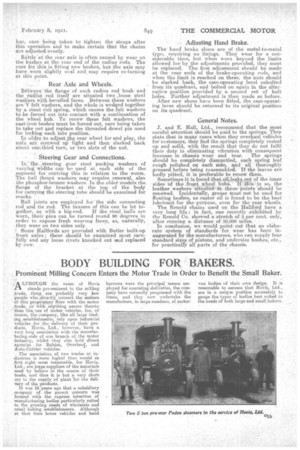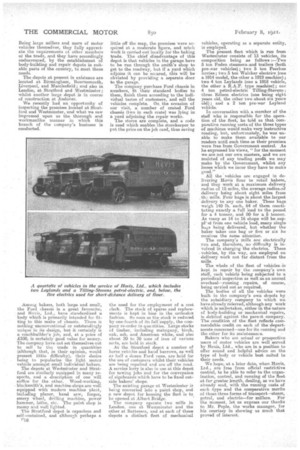BODY BUILDING FOR BAKERS.
Page 15

Page 16

If you've noticed an error in this article please click here to report it so we can fix it.
, Prominent Milling Concern E nters the Motor Trade in Order to Benefit the Small Baker.
ALT"the name of liovis stands pie-eminent in the milling trade, thei;e. are. probably very few people who directly connect the makers of this.proprietary flour with the motor trade, or with anything nearer thereto than the. use of motor vehicles, for, of Course, the company, like all large trading, establishments, rely upon industrial vehicles :for the delivery ef their products. lions, 'Ltd., however, have a .very long association with the manufacturing-side of one branch of. the motor industry; whilst they also bold direct agencies , for Belsize, Overland, and Auto-Carrier vehicles.
. The a,ssociatioa of two trades or industries is more logical than would at first sght seein reasonable, for lions, Ltd. ,"are, la/ge, suppliers of the materials used by bakers in the course of their trade, and thus it is but a very short cry to the supply of plant 'for the delivery of the products.
It was 16 years ago that a subsidiary company of. the parent concern was formed with the express intention of manufacturing bodies particularly suited to the growing needs of wholesale and retail baking establishments. Although at that time horse vehicles and hand barrows were the principal means em.pkyecl for exeMting deliveries, the company have naturally progressed with the times, and they now undertake the manufacture, in large numbers, of motor van bodies of their own design. It is reasonable to assume that Havis, Ltd., are in a unique position accurately to gauge the types of bodies best suited to the needs of both large and small bakers. Being large millers and users of motor vehicles themselves, they fully appreciate the requirements of other members of the trade, and they have accordingly endeavoured, by the establishment of body-building and repair depots in suitable parts of the country, to meet these needs.
The depots at present in existence are located at Birmingham, Bournemouth, Liverpool, and Macclesfield; and also in London, at Stratford and Westminster; whilst another large depot. is in course of construction at Andover.
We recently had an opportunity of inspecting the premises located at Stratford and Westminster, and what we saw impressed upon us the thorough and workmanlike manner in which this branch of the company's business is conducted.
Among bakers, both large and small, the Ford chassis is a great favourite, , and :Heels, Ltd., have standardized a body which is primarily intended for fitting to this make of chaesis. There is nothing unconventional or outstandingly unique in its design, but it certainly is a coaelibuilder's job, and, at a price of 100, is certainly good value for money. The company have not set themselves out to sell to the trade in .quantities (although that, in their opinion, would present little difficulty), their desire being to popularize the light motor vehicle amongst small individual bakers.
The depots at Westminster and Stratford are similarly equipped in many resports, and a description of one will suffice for the other. Wood-working, blacksmith's, and machine shops are welt equipped with modern machine plant, including planer, band saw, forges, emery wheel, drilling machine, pewee hammer, lathe, etc. The paint shop is roomy and well lighted.
The Stratford depot is capacious and self-contained, and althmel„di perhaps a (116
little off the map, the premises were acquired at a moderate figure, and nffich work is carried out lecally for the baking trade. The chief disadvantage of this depot is that vehicles in, the garage have to be run through the smith's shop to get to the roadway, but if a yard which adjoins it can be secured, •this will be obviated by providing a separate door to the garage. The cempeny purchase Ford chassis in numbers, fit their standard bodies to them, finish them according to the individual tastes of customers, and sell the vehicles complete. On, the occasion of our visit, a number of crated Ford chassis (two in each crate) was lying in a yard adjoining the repair works. The stores are complete, and a code is used which enables the storekeeper to put the price on the job card, thus saving
the need for the emplqyment of a cast clerk. The stock of spares and replacements is kept in bins in the orthodox fashion. So soon as the stock is reduced by one-fourth of its full -supply, the cornpuny re-order in quantities. .Large stocks of timber, including mahogany, birch, oak, ash, and American white, and also about 20 to 30 tons of iron of various Sorts, are held in stock.
At the Stratford depot a number of horse yehicles and hand barrow*, as well as half a dozen Ford vans, are held for the use of customers whilst their vehicles are being repaired and are off the road. A service lorry is also in use at this depot for towing jobs and for the conveyance of signboards which have to be fixed outside bakers' shops.
The existing garage at Westminster is being converted into a paint shop, and a new depot for housing tbe fleet is to be opened at Albert Bridge.
The company operate two mills in London, one at Westminster and the other at Battersea, and at each of these depots a distinct fleet of mechanical
vehicles, operating as a separate entity, is employed.
The present fleet which is run from Westminster consists of 13 vehicles, its composition being as fellows :—Two 5 ton Foden steamers-and trailers (both pre-war vehicles); two 5 ton Peerless lorries; two 5 ton Walcker electrics (one a 1014 model, the other a 1919 machine); two 4 ton Leylands (one a. 1918 vehicle, the other a R.A.P. type machine); one 4 ton petrol-electric Tilling-Stevens ; three Edison electrics (one being eig'et years old, the other two about six years old); and a 2 ton pre-war Leyland vehicle.
In conversation with a member of the staff who is responsible for the operation of the fleet, he teld us that cornputative running costs of the three types of machines would make very instructive reading, but, unfortunately, he was unable to make them available to our readers until such time as their premises were free from Government control. As he expressed his views, 'for the moment we are not our own masters, and we are mulcted of any trading profit we may make by the Government, whilst any losses which we incur they have to make good."
All the vehicles are engaged in delivering Hovis flour to retail bakers, and they work at a maximum delivery radius of 15 miles, the average raditheof delivery being about eight miles from the mills. Four liege i$ about the largest delivery to any one baker. These bags weigh 140 lb. ea-eh, 64 of them constituting exactly a full load to the pound for a 4 tanner, and 80, for a. 5 tomer. As many as 14 to 16 shops will be suppi' 4 From one vehicle lead, many single bags being delivered, but whether the baker takes one bag or five or six he receives the same attention.
The company's mills are electrically run and, therefore, no difficulty is involved in charging the electrics. These • vehicles, by the way, are employed on delivery work not far distant from the mills.
The whole of the fleet of vehicles is kept in repair by the company's own staff, each vehicle being subjected to a periodical inspection as well as an annual overhaul---running repairs of course, being carried out as required.
The bodies of all the vehicles were built in the company's own depots by the subsidiary 'company to which we have already referred, although any work which is undertaken, either in the nature of body-building or mechanical repairs, is debited against the parent company. The condition of the fleet reflects commendable credit on each of the-departments concerned—one for its running and the other for he maintenance.
Bakers who are actual or prospective users of motor vehicles are well served by Hauls, Ltd., who are in a position to offer sound and helpful advice on the type of body or vehicle best suited to their needs.
We hope, at a later date, when Hovis, Ltd., are free from official restrictive control, to be able to refer to the organization, control, and running of the fleet at far greater length, dealing, as we have already said, with the running costs of each -type and the comparative merits of those three forms of transport—stesen, petrol, and electric—for millers. For the moment, let us express our thanks to Mr. Pople, the works manager, for his ceurtesy in showing us much that proved of interest.






























